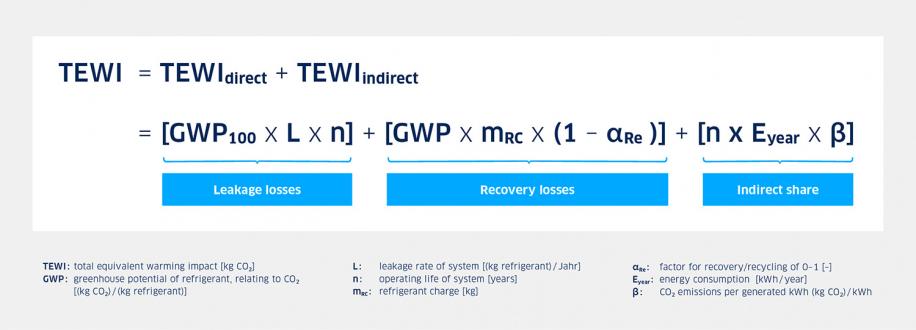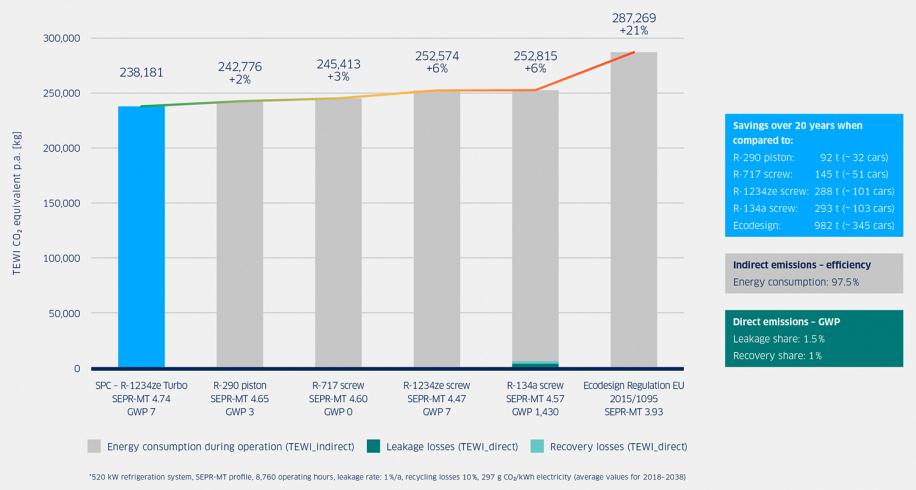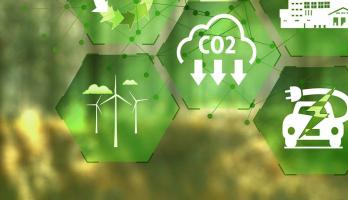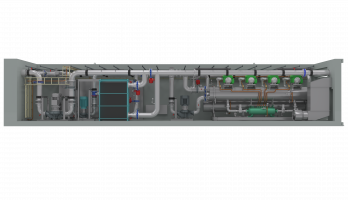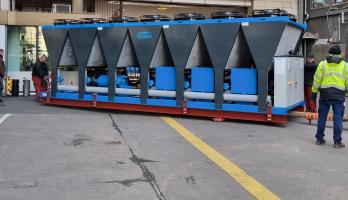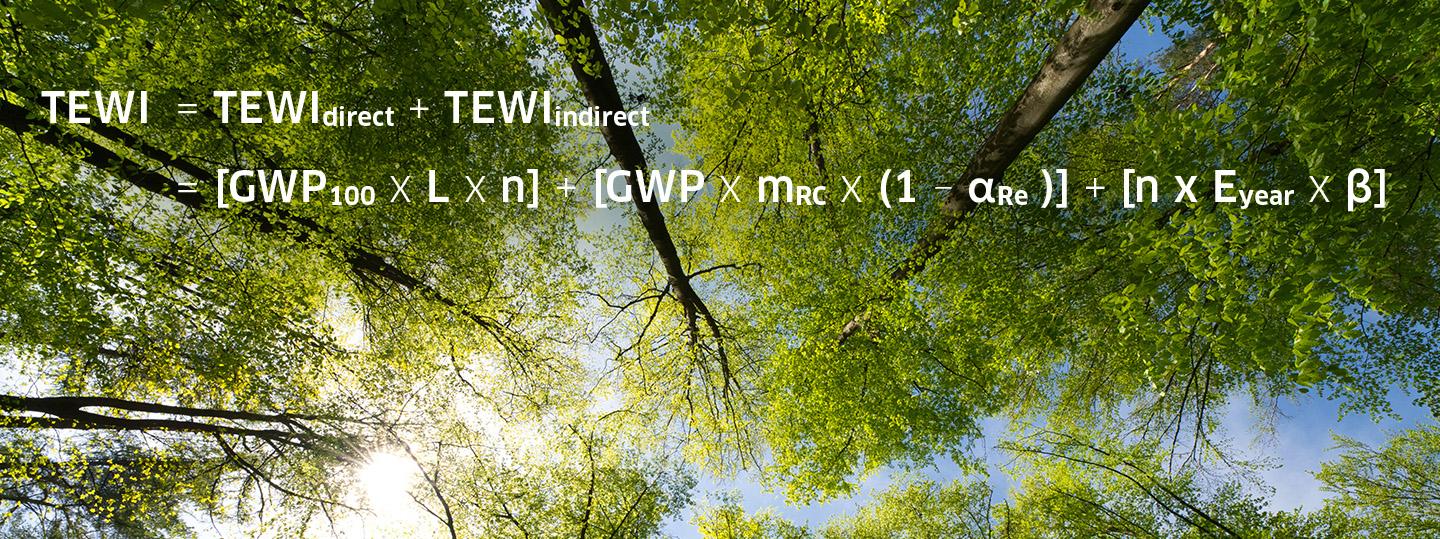
TEWI value in focus: Climate neutrality through energy efficiency
Due to their environmental impact, refrigeration systems and heat pumps have faced increased scrutiny from environmental organisations, governments and the public for some time. Debate has centred on the greenhouse effect of refrigerants, not least because of planned amendments to the F-Gas Regulation, which will make it more stringent. However, the climate relevance of chillers and heat pumps can only be properly assessed with the help of an ecological balance sheet that includes the entire greenhouse effect of the systems. One popular method of holistic ecological assessment is provided by the TEWI value.
Climate protection certainly concerns us all. However, energy-intensive industries such as the cooling and heating industry have a particular responsibility on the path to climate neutrality. Manufacturers, planners and operating companies all need to minimise emissions and ensure high levels of for their systems – in line with the ‘efficiency first’ principle, which is an important cornerstone of the energy transition. After all, the cleanest and cheapest kilowatt-hour is the one that is never even generated. However, when it comes to the climate relevance of refrigeration systems and heat pumps, public discussions currently focus on the refrigerants involved and the greenhouse gas emissions they generate. The value that plays a role here is the Global Warming Potential (GWP) value, which is based on the greenhouse effect of CO2, which has a GWP of 1 by definition. The higher a substance’s GWP value, the stronger its greenhouse effect. In order to achieve the ambitious climate targets of the European Union and help reduce emissions in the industrial sector by 2030, refrigerants with a high GWP value will be phased down or even phased out. These bans and artificial restrictions of availability should encourage the use of refrigerants with a low GWP. They are controlled by the regulatory stipulations of Regulation (EU) No. 517/2014 of the European Parliament and of the Council of 16 April 2014 on fluorinated greenhouse gases, also referred to as the F-Gas Regulation. As the Regulation is about to be amended and made stricter, the greenhouse gas emissions of chillers are coming under increasing scrutiny in terms of their refrigerants. But can the climate relevance of chillers and heat pumps even be assessed in this way?
TEWI value: A look at direct and indirect emissions
Roman Steddin, Product Manager at ENGIE Refrigeration, explains: ‘The GWP value is a useful first step in assessing the greenhouse potential of a system. However, it only assesses the refrigerant, and thus the direct emissions of the system. An ecological assessment of a system cannot be completed using only the GWP value of the refrigerant. To gain a meaningful assessment of the climate relevance of chillers and heat pumps, it makes sense to examine the entire ecological balance of the machine, which includes indirect greenhouse effects as well as direct emissions.’ One suitable technical approach that has proved itself in practice is the TEWI (Total Equivalent Warming Impact) value: Like other values, it includes the direct greenhouse potential of the refrigerant that escapes into the atmosphere during operation, maintenance and disposal via leaks and recycling losses. However, it also incorporates the indirect share in the CO2, a greenhouse gas, that is emitted through the generation of power for driving the compressor. This is because the total emissions of a system depend heavily on whether the power for the compressor is provided from a coal plant or from renewable energies, and on the level of energy consumption and thus the energy efficiency of the system.
According to DIN EN 378-1, the TEWI value is calculated as follows:
The TEWI value assesses environmental efficiency
If the electricity for powering the compressor is produced by the current electricity mix in Germany, with an average annual emission factor (β) of ~480 gCO2eq/kWhel (as of 2022), a system’s indirect emissions, and thus its energy efficiency, are a crucial factor in the TEWI value. The calculation method has its limits, because the absolute result depends heavily on boundary parameters such as the climate zone, operating times, load profile and frequency of servicing of the machine in question. However, Roman Steddin believes there is a huge added benefit as well: ‘Assessing the absolute result is much less important than the fact that the TEWI value provides information on the relationship between the direct and indirect emissions of a system. This information can be used to develop effective measures that mitigate the actual effect of a chiller or heat pump on the greenhouse effect.’ When identical boundary parameters are applied to systems with different refrigerants and different levels of efficiency, the TEWI approach makes it possible to compare the total environmental aspects of the systems. Because there is still no perfect refrigerant for all applications. Instead, the perfect solution needs to be worked out for each application. The TEWI assessment can also be applied to conventional heat generators, which makes it possible to include the carbon emissions that are avoided by using a heat pump instead of gas or oil boilers. As a result, the TEWI value is an important basis for decision-making for all planners of corresponding systems.
Energy efficiency beats GWP value
This is illustrated by a TEWI calculation example, a comparison between the new SPECTRUM Water chiller with highly efficient oil-free turbo compressors, the low-GWP refrigerant R-1234ze, and 520 kW of rated refrigeration capacity, and other refrigeration systems on the market in the same performance class: The calculations were performed on the basis of the SEPR-MT standard load profile in line with Regulation (EU) 2015/1095. If the required electricity is obtained from the German electricity mix, the indirect emissions and thus the system’s efficiency make up more than 99 per cent of the total emissions of the system in question. With natural and low-GWP refrigerants, on the other hand, and assuming a ‘permanently tight design’ with leakage rates of no more than 1 per cent of the filling volume per year, the direct emissions make up a share of less than 1 per cent of total annual emissions. Even with refrigerants with a comparatively high GWP value, such as R-134a (GWP: 1,430 kgCO2eq/kg), the direct share from leak and recovery losses makes up just 2.5 per cent of total emissions. ‘In this assessment, the system that uses the refrigerant with the lowest GWP value is not the one with the lowest total emissions. Instead, it is the system with the highest seasonal energy efficiency. And in this example, that is our SPECTRUM Water chiller,’ Roman Steddin explains.
TEWI value reveals carbon savings
Over an operating life of 20 years, high levels of energy efficiency make it possible to achieve significant carbon savings when compared to other systems in the same performance class on the market – even systems with natural refrigerants such as propane (R-290) or ammonia (R-717). Where the system serving as a comparison only just reaches the minimum efficiency requirements for ecodesign in line with Regulation (EU) 2015/1095 (SEPR-MT: 3.93), the TEWI comparison shows that the SPECTRUM Water chiller saves around 980 tonnes of CO2 over 20 years – the equivalent of the carbon emissions from 345 petrol cars, each driving 20,000 km per year. From this, it can be deduced that refrigerants from a natural source and with a low GWP value are not suitable from a climate perspective if they are used in an inefficient solution with a high energy consumption. ‘Efficiency, and thus indirect emissions, makes up the majority of total emissions. This means that, next to expanding renewable energies, this is the most important parameter on our path to climate neutrality that we are currently aware of.’
Climate-friendly: ENGIE Refrigeration has mastered energy efficiency
ENGIE Refrigeration has focussed on the energy efficiency of its products for many years – and keeps setting new standards on the international market. The QUANTUM Water chiller, for example, has been one of the most efficient water-cooled chillers on the market since its launch in June 2021. Then there is the SPECTRUM Water heat pump, which was launched in March 2022; it has very high levels of energy efficiency, and thus an exceedingly low total ecological balance. Our portfolio also includes machines with natural refrigerants, such as the thermeco2 high-temperature heat pump with the natural refrigerant CO2 (R-744). Roman Steddin says: ‘In the long term, the GWP value of the refrigerant will become increasingly significant in the TEWI calculation, assuming that the electricity powering the compressor is fully provided from renewable sources. In that case, the specific emissions of power consumption would approach 0 g CO2eq/kWh, and the indirect emissions of the system would thus decrease steadily. That is why we are increasingly switching to low-GWP and natural refrigerants for our systems.’ However, the energy mix in Germany is still largely dominated by coal plants with very high specific CO2 emissions (~1,100 g CO2eq/kWhel). Photovoltaics and wind power are highly volatile and play almost no role in the German electricity mix on windless or cloudy days. For this reason, ‘efficiency first’ is the most important order of the day, along with the expansion of renewable energies – and the TEWI value is a useful method that allows all users to comprehensively assess the climate relevance of their chillers and heat pumps.
